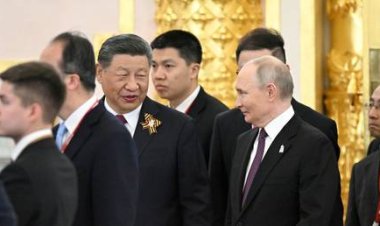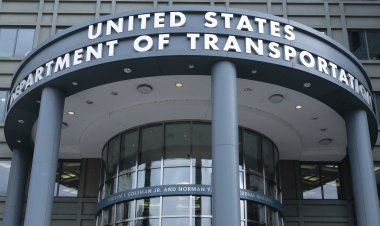The Tired Monotony of a Trump Rally in 2024
Everyone’s just going through the motions.


ATKINSON, New Hampshire — The line snaked along the driveway, hundreds of people long. The weather was dreadful in southern New Hampshire — ice and the slush and the subfreezing temperatures — but Donald Trump’s faithful didn’t care. They were willing to wait two hours in the freezing cold, and three more in an airless ballroom, to witness what promised to be a triumphal occasion: The day before, their besieged champion had won a resounding victory in Iowa, and tonight’s rally would be his victory lap. The night held forth the possibility of Vintage Trump — punchy, emboldened, zany — and they were willing to wait for it.
Just after 7 p.m., Trump took the stage, two hours late. “If you think that it was easy to get here, you are wrong,” said Trump, who arrived in a militarized motorcade driven by combat-trained drivers. His audience — who had navigated their SUVs and pickup trucks across slick highways and frozen back roads — chuckled awkwardly. It was clear Trump did not want to be here.
Trump’s rallies, once the primary attraction in the MAGA universe, have become awkward sideshows in his grander political drama, which is now unfolding primarily in closed courtrooms and six-page legal orders. (Just that morning, Trump had appeared in court in New York.)

But something deeper than distraction or fatigue plagued the former president’s appearances in New Hampshire. Trump’s speeches have always been rambling and directionless, but in 2024, they have the additional drawback of being inescapably monotonous.
His rallies aren’t fundamentally different than they have been in past elections, but therein lies the problem: There’s little new substance or material in this year’s revival of the Trump Show. His core grievances — against the “radical left Democrats,” the deep state, the RINOs, the globalists, the media — are little changed since he first started running for president in 2015, and his schticks — spinning out new nicknames for his rivals, goading the crowd to boo the press — are all retreads. Trump may still be full of venom and fury, but his laugh lines feel wooden and rehearsed, his digressions lacking color and zing.
And his fans — though, on the whole, as enthusiastic as ever — seem to be taking note. Last Saturday evening in Manchester, Trump spoke to a crowd of 5,000 inside a frigid minor league ice hockey stadium. Toward the end of his nearly two-hour speech, a soaring orchestral soundtrack came on over the PA system, and an American flag began billowing on the screen behind him. This was supposed to be the climactic culmination of his speech, but as Trump droned on — for five, 10, 15 minutes longer — even the supporters standing behind him on the stage started to look a little bored. Out in the stands, a steady stream of attendees trickled toward the exits.
The stilted tone of the rallies may not matter for Trump’s electoral chances — he has romped through primary challenges so far in Iowa and New Hampshire, and polls show him with a slight edge over President Joe Biden in a general election matchup — but it certainly matters for how the country prepares for his possible return to the White House.
Last week, ahead of the Iowa caucuses, The Atlantic’s McKay Coppins urged readers to show up to a Trump rally — “not as a supporter or as protester, necessarily, but as an observer.” In 2016 and 2020, Coppins argued, Trump watchers scrutinized every one of his rallies, dissecting them for clues into Trump’s erratic psyche. But in 2024, Coppins contended, an overcorrection has occurred: Now, the country isn’t paying enough attention to Trump. He has been rendered “an abstraction” — a “hazy silhouette … formed by preconceived notions and outdated impressions.”

Trump is, no doubt, less omnipresent than he once was. His Truth Social posts no longer drive entire news cycles, and the major networks rarely broadcast his full speeches. But, based on his recent swing through New Hampshire, Trump’s speeches don’t teach us much about Trump or his plans for a second term that we don’t already know. I arrived at Trump’s rallies as a prime target for Coppins’ advice — a Brooklyn journalist who has followed Trump closely but, until last week, had never been to a rally in person — and I came away thinking this: The reason to ignore the rallies is not merely to avoid “amplifying [Trump’s] lies,” as Coppins put it, but also because they have little to offer anyone but Trump’s most loyal fans, either in the way of education or entertainment.
Reflecting on his own experience of a Trump rally, Coppins took note of a “rote quality” in Trump’s speeches, adding that the former president seems to have “lost the instinct for entertainment that once made him so interesting to audiences.” But this perhaps understates the case. Trump’s speeches aren’t boring merely because they’re rote, but also because so much of his material is inherently incoherent and uninteresting.
In speech after speech in New Hampshire, Trump mentioned, in no particular order: Joe Biden’s inability to pick up a beach chair; his uncle Dr. John Trump’s career at MIT; Al Capone and Scarface; the difference between prison and jails; Hannibal Lecter; a real estate deal with Ted Kennedy; and the weather in Iowa. Trying to discern a clear picture of Trump or his plans for a second term from these remarks is like trying to find patterns in a Pollock painting.

The rallies provide only limited insight into the movement that Trump leads. Off the campaign trail, Trump and his allies in Washington have not been shy about touting their policy prescriptions for a possible second term, which include a sweeping crackdown on immigration, an overhaul of the federal bureaucracy, an expansion of protectionist trade policies, a retreat from multilateral alliances and acampaign of political retribution against his enemies. At think tanks and in the right-leaning press, conservatives are still hashing out the debates — about the political economy, foreign policy, philosophy, conservative history and even art and culture — that Trump’s election in 2016 sparked. Yet none of these substantive issues received more than passing mention at Trump’s campaign events. Coming away from a Trump rally, a neutral observer could be forgiven for thinking that Trumpism — as opposed to Trump himself — is less complex and contradictory than it actually is.
Nor do hasty interviews with Trump’s supporters — now a well-worn cliché of the liberal-goes-to-a-Trump rally genre — supply much of a novel window into the Trumpian zeitgeist. In Atkinson, a woman in a MAGA hat and scarf (“Let’s go with ‘Paula,’” she said when I asked for her name) told me that her top issue was the economy, although her own company — a construction outfit that builds on government contracts — was booming. A pair of elderly brothers, George and Larry Phillis, said their top issue was immigration — but they confessed that they didn’t see much evidence of the immigration crisis in northern New England. One hears variations of these concerns over and over again, punctuated with darker musings about Democrats’ efforts to rig elections and the inevitability of immigrant-led terrorist attacks.
Around 6 p.m. in Atkinson — an hour after Trump was slated to appear — a woman in a bedazzled Trump shirt turned to the man next to her and asked, “Where is this guy?” Even after hearing his hour-long speech, it was hard to say.
Last Wednesday, Trump’s fans gathered at a cramped hotel ballroom near the harbor. Once again, he was over two hours late thanks to another appearance in court, where he blabbered and blustered with such bravado that the judge threated to throw him out.
In Portsmouth, meanwhile, his fans were getting itchy.
“I can’t stand this shit anymore!” shouted an attendee as she headed for the hotel exit. “It’s disrespectful!”


She had a point. In 2024, attending a Trump rally is a feat of physical stamina. To gain access, prospective attendees stand in line for several hours — often, in the case of New Hampshire and Iowa, in freezing temperatures — to clear Secret Service screenings and secure a limited number of seats. Trump might not be an incumbent president, but he has the full security trappings of one.
Once inside, a select few get to sit in not-especially-comfortable chairs, while the rest shift their weight uncomfortably from one foot to the other, often in tight quarters, for a few more hours. After several hours of standing around in Portsmouth, I slumped down on the floor next to a woman who told me that she had vascular problems in her legs and feared a serious medical emergency if she was forced to stand for any longer.

For Trump’s dedicated supporters — who, at this point, make up the overwhelming majority of the rallies' crowds — the payoff is clear enough: a chance to bask in the Trumpian aura, snap a few pictures and a participate in a collective venting session. At a rally on Friday in Concord, I spoke to MAGA die-hard Edward X. Young, who has attended close to 70 Trump rallies since 2016. “They give me hope,” he said, when I asked him what kept him coming back. “Politics aside, Trump rallies are the greatest show on earth.”
Toward the end of last week, Trump drew larger crowds in Concord, where he packed a large hotel ballroom, and Manchester, where he filled the lower bowl of a small arena. But even with the larger crowds, Trump was going through the motions — attacking Nikki Haley, the radical left Democrats, the deep state. In Concord, a man waved a large cardboard sign reading: “We are 100 percent with you, President Trump!” He walked out about three-quarters of the way through Trump’s speech.












